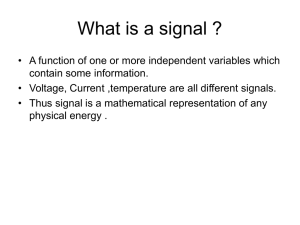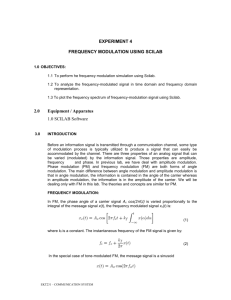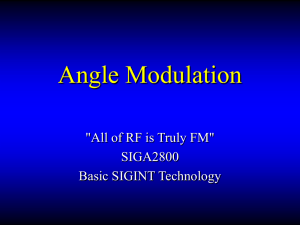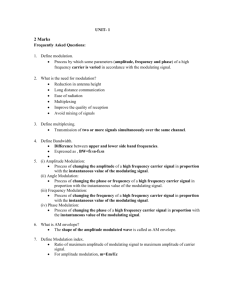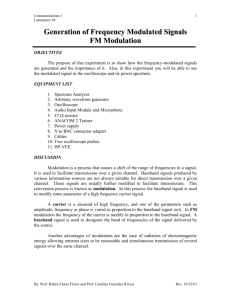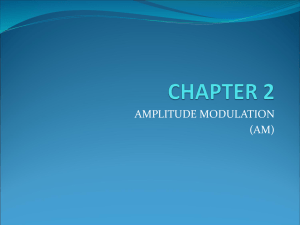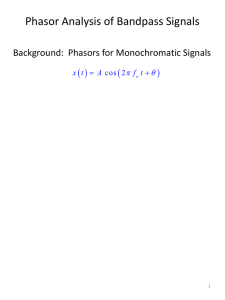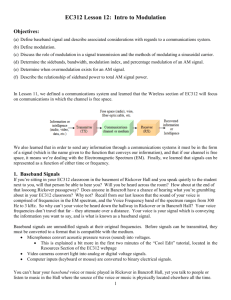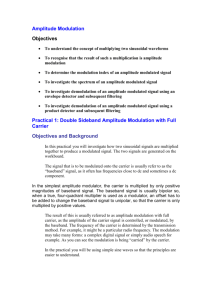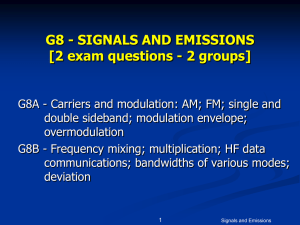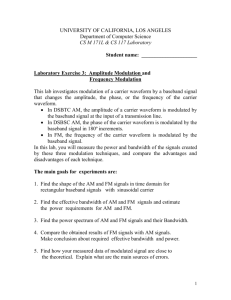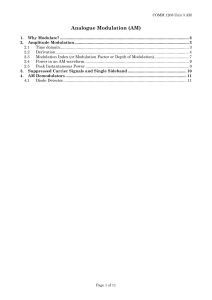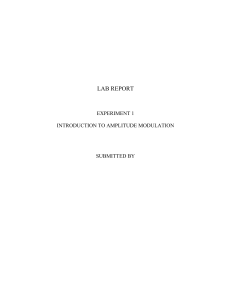2 chapter
advertisement
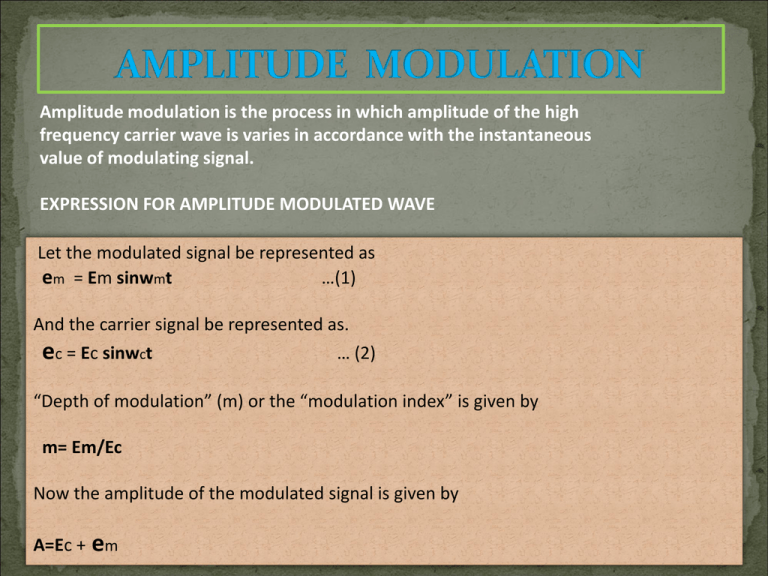
Amplitude modulation is the process in which amplitude of the high
frequency carrier wave is varies in accordance with the instantaneous
value of modulating signal.
EXPRESSION FOR AMPLITUDE MODULATED WAVE
Let the modulated signal be represented as
em = Em sinwmt
…(1)
And the carrier signal be represented as.
ec = Ec sinwct
… (2)
“Depth of modulation” (m) or the “modulation index” is given by
m= Em/Ec
Now the amplitude of the modulated signal is given by
A=Ec + em
= Ec + Em sinwmt
= Ec +m Ec sinwmt
= Ec [1+m sinwmt]
… (3)
Thus amplitude modulated signal can be represented in time domain as
E = A sin0
E= A sinwct
= Ec [1+m sinwmt]* sinwct
= Ec sinwct +mEc sinwct sinwmt
= Ec sinwct +(mEc /2)*2 sinwct sinwmt
= Ec sinwct +(mEc /2) [cos( wc +wm)t + cos( wc-wm)t]
…(4)
Thus it has been shown that the equation of an amplitude modulated wave contains
three terms. The first term is identical to equation (2) and represent the the
unmodulated carrier. It is thus apparent that the process of amplitude modulation has
the effect of adding term to the unmodulated wave, rather than changing it.
Modulation index can be practically can be
calculated measured using two method.
•Using an AM signal.
•Using an trapezoidal display.
Carrier signal
Modulator
Modulating
signal
CRO
t
(a) Modulating signal
t
(b) Carrier signal
Em
Em
Emax
Ec
Emin
(c) Amplitude modulated signal
t
Q.1)
Sol.
M = Emax-Emin
Emax+Emin
M=Em/Ec
m = Emax - Emin/2
….1
Ec=Emax - Em
=Emax -( Emax-Emin/2 )
=Emax+Emin/2
…2
Dividing (1) by (2)
M = Emax-Emin
Emax+Emin
…3
Equation (3) standard method of evaluating modulation index
Em
Ec
A
B
AM signal
Modulated signal
t
In this method the Am signal is connected vertical deflection and the
modulation signal is applied to the horizontal deflection plate of the
oscilloscope. The display on the screen of oscilloscope is trapezoidal as
shown in fig.
A=2(Ec + Em)
……1
B=2( Ec-Em)
……2
Adding (1) and (2)
A+B=4Ec
Ec=(A + b) / 4
……3
subtracting (1) and (2)
A-B=4Em
Em= (A-B) / 4
…….4
Modulation index
mf = Em/ Ec = (A-b) / ( A+b )
Relative Power Distribution in AM Wave
It is clear that modulated carrier wave contain more power as compared to
unmodulated wave became of fact it contain two or more side band. The total
power will depend upon the modulation index.
2
2
Pt = Ec + ELSB + EUSB
R
R
2
………….(1)
R
Where all the voltage signal have r.m.s value and R represents the antenna
resistance.
Pc = (Ec /
2
)2
R
2
=Ec /2R
……………(2)
Similarly Plsb = Pusb
=m2Ec2 / 8R
=
[ (m Ec/2) /
………(3)
2
2
]
Putting the value of (2) and (3) in equation (1). Then result is :
Pt = Pc [ 1 + m2 / 2]
2
The maximum power in the AM corresponding to m=1 is Pt = 1.5 Pc.
This is important that relevant amplifier must be capable of handling
without distortion.
Current Calculation
Let Ic be the unmodulated carrier current and It be the modulated
current r is the resistance in which the current flow.
2
2
Pt / Pc = It R / Ic R
It / Ic =
It = Ic
2
1+ m /2
2
1+ m / 2
2
= [ 1 + m /2 ]
If the frequency of the carrier is made to varying in accordance with instantaneous
Value of the modulating signal, the process is called FM.
Expression: In FM the frequency of the carrier varies the amount by which the carrier
frequency and varied from its unmodulated value is called deviation.
And the deviation is perpendicular to the Instantaneous value of
modulating signal. The instantaneous value of frequency of the modulated carreier is
given by:
f = fc + fc kf Em coswmt
= fc [1 + kf Em coswmt ]
……..(1)
Fc = unmodulated carrier frequency.
Kf = proportionality constant
Em coswmt = Instantaneous modulated voltage
Maximum Frequency deviation
fmin = fc (1-kEm)
fmax = fc (1+kEm)[]
= fmax – fc = fc – fmin = kf Emfc ……….2
Considering again equation (1)
f = fc [1 + kf Em coswmt ]
w = wc [1 + kf Em coswmt ]
But angular velocity
W= do / dt
O = wdt
Put the value of w
O = wc [1 + kf Em cos wmt ] dt
= wct + wc kf Em sinwmt
wm
fmax
fc
fmin
O(t) = wct +
sinwmt
fm
…………(3) from 2
The carrier wave efmt may be written as
efm(t) = Ec sinO(t)
Put the value of O(t) in above equation
efm(t) = Ec sin (wct +
sinwmt ) ………..(4)
fm
The modulation index of FM
Mf = Max frequency deviation
Modulating frequency
=
……….(5)
fm
From equation (4) and (5)
efm(t) = Ec sin (wct + Mf fm sinwmt ) ………..(4)
fm
efm(t) = Ec sin (wct + Mf sinwmt ) Ans.
The Expression for FM is not simple. It is complex since, it is a sine of
sine function. The only way to solve this equation is using Bessel’s
Function. By using Bessel’s Function. The equation for FM wave can be
expanded. As follows.
efm = s(t)= Ec { jo (Mf) sinwct } + j1Mf { sin( wc +wm)t – sin (wc-wm)t }
+j2Mf { sin(wc+2wm) t + sin (wc-2wm)t }+
j3Mf { sin( wc+3wm)t – sin (wc-3wm)t } +
j4Mf { sin( wc +4wm)t – sin (wc-4wm)t } +………….(*)
1. The FM wave constant of carrier. The first term in equation the
carrier.
2. FM consist of infinite no. of side band. All terms except first term.
3. The amplitude of the carrier and the side band depend is depends
on ‘j’ coefficient. The value of these coefficient can be term the
graph.
For equation j1(Mf) denotes the value of j1 for the particular value of
Mf written inside the bracket.
Mf
jo
.01
.25
------------------
j1
-------------
j2
-----------------
In Mf wave, the total transmitted power always remain constant. It is
not dependent upon modulation index. The region for this is that the
amplitude of FM wave is constant.
2
Pt =( a/ 2) = A
R
2
R
Where ’A’ peak amplitude of FM wave .It is equal to
2
Pt = A
R
where R =1
1) Amplitude of AM wave will change
With modulating voltage.
2) Transmitted power is dependent on
the Modulation index.
Amplitude of Fm is constant. It is
independent of modulation index.
Transmitted power remain
constant. It is interdependent on
the Modulation index.
3) Carrier power and one side band power
is useful.
All the transmitted power is useful.
4) AM receiver are non immune to noise.
They are immune to noise.
5) It is not possible to decrease noise
further by increasing deviation
It is possible to decrease noise
further by increasing deviation
Bandwidth = 2(
BW depends on
+ fm ) .
. BW is much
Bandwidth = 2 fm
less than FM.
Ground wave and sky wave
Space wave is used for propagation
propagation is used. Therefore large
area is concerned.
AM equipments for modulation are
less complex.
No. of side band will be two and
more constant.
BW is large hence wide channel is
required.
so radius of transmission is limited.
FM transmission and reception the
equipment are complex.
NO. of side band having significant
amplitude depends upon
modulation index.
FM
PM
S(t) = Ec sin( wct + mf sinwmt)
S(t) = Ec sin( wct + mp sinwmt)
Frequency modulation is
Phase modulation is proportional to
proportional to modulating
voltage.
Mf is proportional to modulating
voltage as well as the modulating
frequency.
It is widely used.
It is possible to receive FM on PM
receiver
Noise immunity is better than AM
an PM
modulating voltage.
Mp is proportional only to
modulating voltage.
Used in some mobile system.
It is possible to receive PM on FM
receiver.
Noise immunity is better than AM
but worst than PM

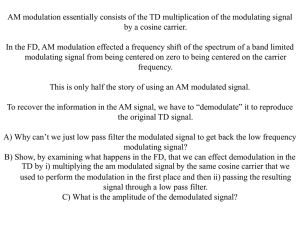
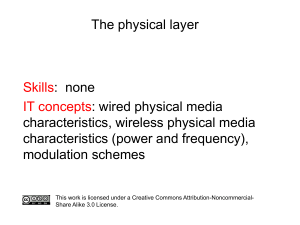
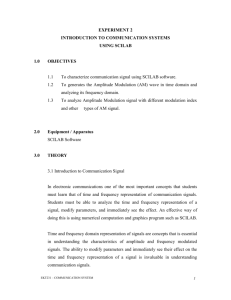
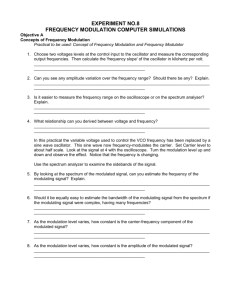

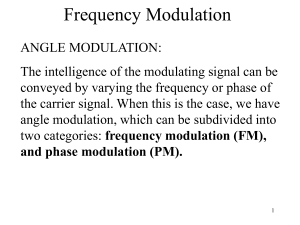
![( ) ( ) ] ( )t - Electrical and Computer Engineering at UNC Charlotte!](http://s3.studylib.net/store/data/008111395_1-93714dad75fd37a24d3ca03a1e986ddf-300x300.png)
